Alaska -- Closed Till Break-up
April, 2002
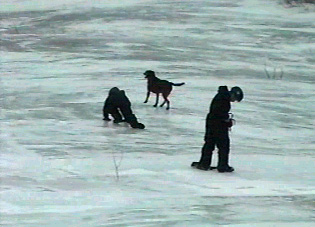 |
We came to Alaska early to help Cheryl's sister move
to her homestead 50 miles from the nearest town, road, or store.
With that done, we thought we would go see the rest of Alaska. What
we discovered was that all of Alaska was still frozen and everything was
closed. During April and half of May we traveled from Fairbanks,
past Mt. McKinley and Denali National Park, to Anchorage, the Kenai Peninsula,
back through Anchorage, to Valdez, then back up through Delta Junction
to Fairbanks. That covers almost every highway in Alaska. |
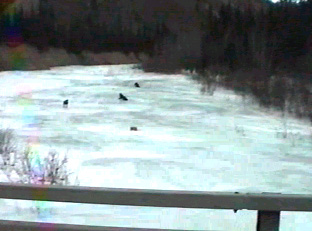 |
In these two pictures Mitch and Max are climbing up a
frozen river. It's solid ice, fairly steep and climbing is
difficult. It was really cool to see rivers and waterfalls of solid ice.
None of the RV parks, tourist attractions or tours were open or operating,
so we made our own fun. |
| On our way to the Kenai Peninsula we stopped at the top
of Turnagain Pass to watch some guys on snow machines driving straight
up the side of the mountains.
This school bus was returning to the city of Kenai after
a trip to Anchorage. They stopped to use the restroom, loaded back up and
started to drive away. Suddenly the bus came to a very abrupt stop.
The bus had fallen through the ice on the parking lot. |
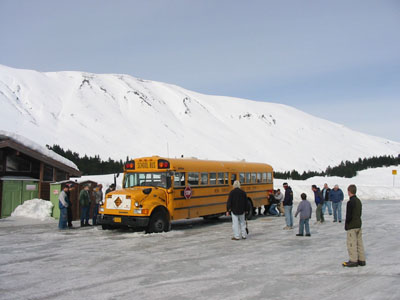 |
The pull off at the summit was covered with 16 inches of
compact snow and ice. When a car pulls off for a restroom stop, the
warmth from the tires melts a quarter-inch of the ice. Now, for my
scientific theory -- after hours of contemplation, (yes, I have some extra
time on the hands) -- though still cool, during the warmer afternoons the
thin layer of melted water absorbs the sun's heat instead of reflecting
it like the white compact snow. The small puddle from the car's tires
continues to melt all the way to the pavement, 16 inches deep. At
night the top three inches of the puddle freezes over. The bus drove
over two of these puddles with each front tire, broke through the 3 inch
ice, and was stuck.
I got out a pick and shovel, some boards and chains and
hooked up to a truck with 4 wheel drive. Along with the high school
staff and students, we pushed, we pulled and finally, . . . . we
called a tow truck and all went sledding. Finally, a big DOT truck
filled with a load of sand pulled up. He tried several times to pull
the bus out and finally was able to do the job. While there,
we discovered it was difficult to walk across the lot without falling through
these puddles. There were weak spots in the ice everywhere and we saw several
cars pop either a front or rear tire through the ice as well. We
said our good-byes to the high school kids and staff and felt lucky to
drive out without getting stuck ourselves.
We drove down the other side of the pass and started up
a hill. As we approached the halfway mark of the hill, we saw the
bus again. This time it was coasting backwards down the hill.
We slowed as we passed them and heard the bus driver yell out his window
that
the clutch had gone out. The bus backed down to the bottom of the
hill and around a corner, so we pulled over with them. By now a couple
of hours had passed since our first meeting and the kids were getting hungry
and thirsty. We got out our big jug of water and some snacks. The
boys got out their footballs and baseballs as we all played and waited
another two hours for a second bus to show up.

A few days later we stopped by the high school and joined
them for lunch and played a video we had made entitled, "The Day the Bus
Stood Still". They really liked the part when their principal was
sledding down a big hill getting snow in his face and catching a lot of
air. It looked like a real rough ride, but the kids loved it.
The local newspaper, the Kenai Peninsula Clarion, stopped by and wrote
an article about us and our time with them. Click
here if you'd like to see an online version of the Clarion's article,
(but you might want to do so after you're finished reading this so you
don't have to reload this page.)
| We have hundreds of the usual vacation-type pictures,
so I'll only stick in the more unusual ones. This picture is a frame
from our video camera of three eagles battling for a fish. The two
lower eagles have their talons on the fish and are tumbling and struggling
for it as they drop 500 - 800 feet. The third eagle has pulled in
his wings to lose lift and is dropping as fast as the tumbling eagles,
probably in case they both drop the fish. They tumbled with one on
the top one second and the other the next, until they were 50 feet from
the ground. Finally, one pulls out and the other flies off with the
fish with 4 other eagles in pursuit. I managed to catch the whole
flight on video. |
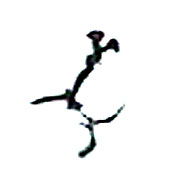 |
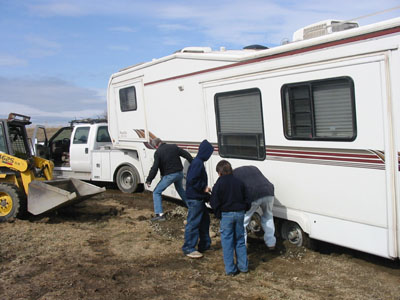 |
Other than the Marine Life Aquarium in Seward, everything
else was still closed. But the weather was getting warmer and spots
were starting to thaw out. Here, we unfortunately found one of them.
When the frozen dirt thaws it thaws from the top down. First the
snow melts and the water has nowhere to go because the ground underneath
is frozen solid. Then the top few inches melt and turn to mud.
As the top two feet melt, the top layer of dirt lifts and it feels like
you're walking on foam rubber. |
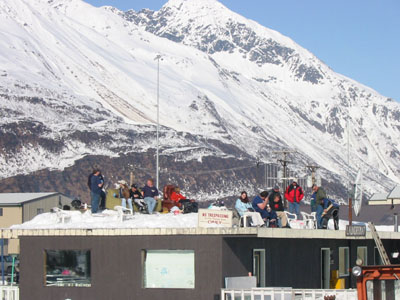 |
One of the most beautiful towns we visited was Valdez.
By the time we arrived there, some of the RV parks were starting to open.
Most parks would clear the snow from five or six spaces for the early-bird
travelers. We could plug into power. Water and sewer?
Still frozen!
This is the office of the RV park where we stayed.
An extreme snow machine film producer was in town to make a sequel to his
video from the previous year. All the locals showed up to have a
barbecue and kegger on the roof and watch the action. |
| Here's a picture of one of the jumps. As you can
see, it would be difficult to back our trailer into this part of the RV
park.
At night these guys would build a huge bonfire between
the base of the ramps and jump over the flames and sparks.
Guess what happens if you don't get your hands back on
the handle bars in time -- they usually ended up with their chin on the
handle bars. A few stitches later they would be back at it again. |
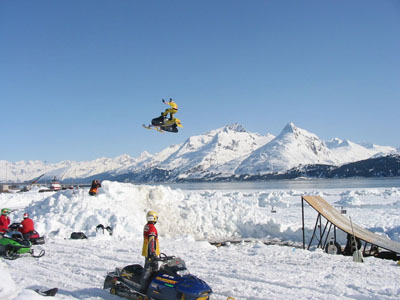 |
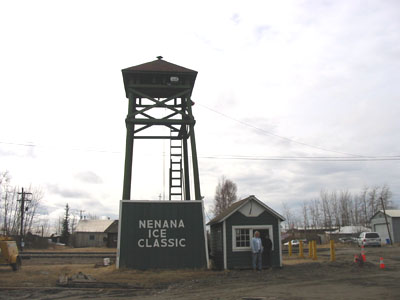 |
Break-up was near, so we thought we'd go see the Nenana
Ice Classic. Every year since 1917 Alaskans have placed $2 bets on
the day, hour and minute that the river ice will break. This is an
extremely popular contest in Alaska and is promoted statewide. Teams
of people join together and form pools to cover the most common times --
the winning pot is about $300,000.
A rope from this tower is attached to a clock and then
strung out to a large tripod. The tripod is anchored 2 feet into
the ice of the Tanana River at the confluence with the Nenana River at
the town of Nenana. Cheryl and Mitch are standing in front of the
guard house which is staffed around the clock during the last few weeks
before break-up. |
| You can barely see the tripod in this picture above Max's
head near the bridge. This is just after the ice broke. As
the river filled with the spring melt water it lifted the frozen ice about
five feet. The two edges along shore broke apart and slightly re-froze.
After another ten days the river cut the ice away on the edges leaving
a very large slab in the center of the river. |
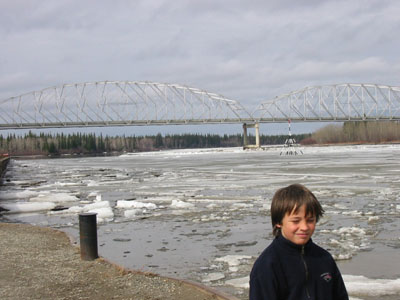 |
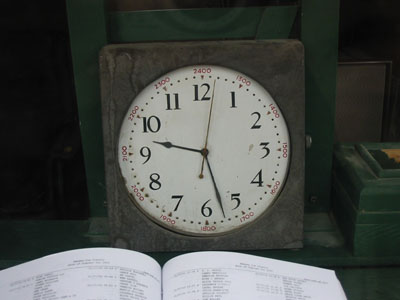 |
At 9:27:02 p.m. on May 7th the large slab broke free
and floated 100 meters down river where is came to rest again. We
were watching the only channel on TV when we heard the siren from the watch
tower. As soon as the siren went off most of the town's 400 residents
came running down to the river.
A log book has all the ticket holders listed by date and
time. Our times had already passed several days earlier. Six winning
names were underlined in red. |
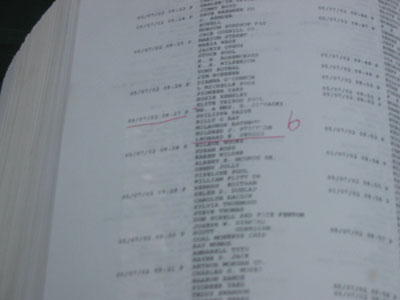 |
When we arrived, a small crowd was already there.
Everybody was huddled around the window looking at the book.
Right behind us I heard someone say, "what time did it
break?" "9:28" replied another. "No, wait, ah 9:27."
"9:27? No way, I have 9:27", said the fellow
behind me. He pushed through to see the book. He looked and
said, "Leonard Anderson" as he read his own name. His wife gasped
and held her face with both hands so her chin would keep from hitting the
ground. Leonard said several times, "Does that say Leonard Anderson?
Read it, what does it say? "You won Leonard!" said another. We were
standing shoulder to shoulder, I turned and said, "$300,000 split 6 ways
-- you just won $50,000!" His wife was still holding her breath. |
This was the first time a local Nenana resident had won in
10 years and only the third to win in 20 years. What great news for
a guy that had just gotten out of the hospital 2 days earlier and hadn't
worked in 6 months. He had also just won a battle against cancer.
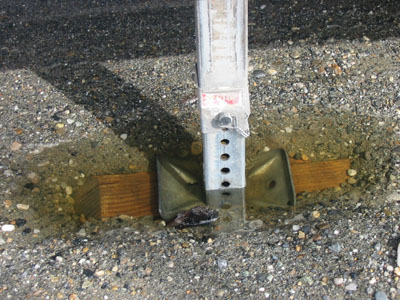 |
We had been in Nenana for a week waiting for the ice
to break. We met several of the local residents and helped a fellow
named Floyd put a large sign in front of his motel back up after a spring
windstorm had blown it down.
The ice wasn't the only thing thawing out. When
we arrived, this 4 x 4 block of wood was on top of the ground. Each
morning I would crank the front legs of the trailer down a little further
to re-level the trailer. As you can see here the 4 x 4 sank about
7 inches during the week. |
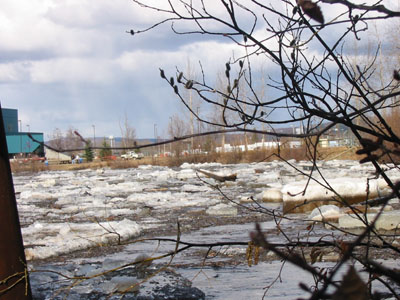 |
Back in Fairbanks the following week we happened upon
another spectacular ice flow. An ice jam 20 miles up the China river
had been causing flooding, but it finally broke loose. It took about
4 hours to flow through downtown Fairbanks.
Some of the ice was 30 by 30 feet across and 18 inches
thick, wieghing . You can see one thick piece as it pushes up on
another to the right side of this picture. |
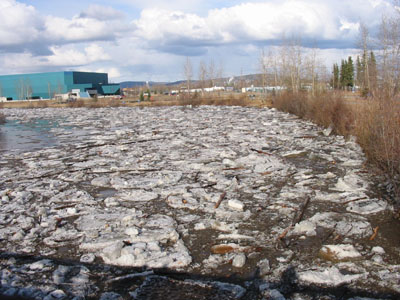 |
The ice is moving about 4 or 5 miles per hour as it scoured
the shore line of small trees. We found a location where a steel
foot bridge crossed the river. The bridge rang out as the ice smashed
against the steel posts holding the bridge. Some years the ice slowly melts,
becomes soggy and slowly washes away. This year was a classic --
tons of ice smashing through town crushing anything in its path. |
ã
copyright Nodland 1999-2020















